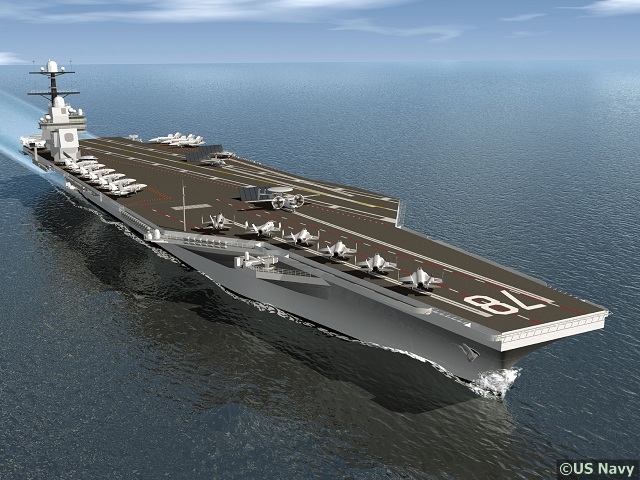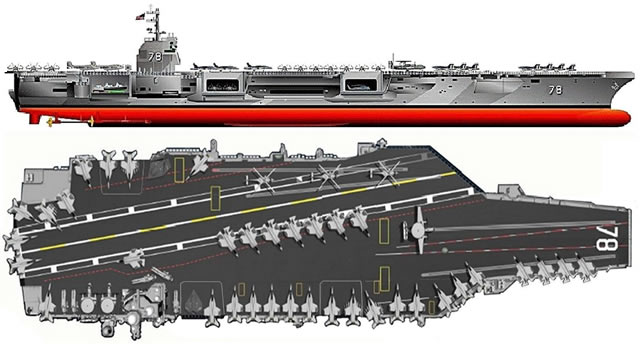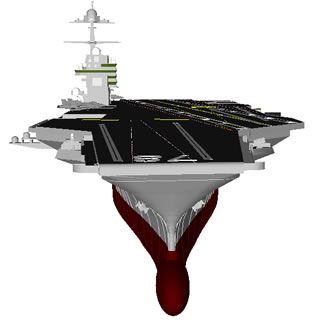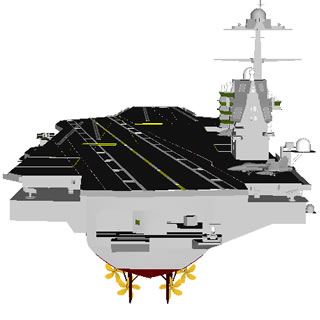|
|
||||||||||||||||||||
| a | ||||||||||||||||||||
|
Gerald R. Ford Class (CVN-78) Aircraft Carrier
also known as CVNX & CVN-21 carrier program |
||||||||||||||||||||
|
|
||||||||||||||||||||
 |
||||||||||||||||||||
|
|
||||||||||||||||||||
|
The Gerald R. Ford class is the future aircraft carrier replacement class for USS Enterprise and the Nimitz class aircraft carriers. CVN-78, CVN-79, and CVN-80 are the first three ships in this U.S. Navy’s new class of nuclear-powered aircraft carriers (CVNs). First of class Gerald R. Ford (CVN 78) was ordered from Newport News Shipbuilding on Sept. 10, 2008, and is scheduled to be delivered in 2015. |
||||||||||||||||||||
| Shiplist | ||||||||||||||||||||
|
||||||||||||||||||||
|
Variants
|
||||||||||||||||||||
|
- None at this time
|
||||||||||||||||||||
| Technical Data | ||||||||||||||||||||
| Design | ||||||||||||||||||||
|
Gerald R. Ford (CVN 78) is the first new US aircraft carrier design in 40 years, replacing the Nimitz class of carriers. The new design brings many performance improvements, including:
» 25 percent increase in sortie generation rate » 2.5 times electrical generation capacity over the Nimitz-class » Manpower reduction of 500 billets The new carrier class was redesigned from the keel to the mast of the island house. Among the improvements: » New reactor and propulsion plants » Electromagnetic Aircraft Launch System (EMALS), an improvement over steam catapult system » New island » All electric ship » Major space rearrangement » Flight deck extensions » Advanced arresting gear Gerald R. Ford (CVN 78) is the U.S. Navy's first aircraft carrier to be completely designed using a 3-dimensional product model. |
||||||||||||||||||||
| New Technologies | ||||||||||||||||||||
|
Among the new technologies in the Ford-class are:
» Dual Band Radar: Enables a smaller island structure on the deck of the carrier, facilitating the ship’s increased sortie generation rate » Multifunction radar and volume search radar: integrates two radars operating on different frequency bands » EMALS: Replaces steam catapult. Uses electrically generated, moving magnetic field to propel aircraft to launch speed. |
||||||||||||||||||||
| Flight deck changes | ||||||||||||||||||||
|
» Flight deck: The island is smaller and moved farther aft than on Nimitz class so there is more area for airplane maintenance and flight deck operations will be faster and safer due to better space utilization
» Weapons Elevator: Elevators use moving electromagnetic fields instead of cabling, which allows elevator shaft to use horizontal doors to close off magazines. This reduces manning and maintenance costs. » Flexible Infrastructure: Flexible infrastructure architecture that allows spaces to be adaptable to rapid changes without the use of “hot work.” It eases compartment reconfiguration to support changing missions, maximizes time for technology development prior to equipment installation, and eliminates cost and schedule impacts associated with the traditional conflicts from re-work. » Advanced Arresting Gear: Recovers current and future aircraft, is lighter than the legacy system, software controls, reduce manning. |
||||||||||||||||||||
| Weapons | ||||||||||||||||||||
|
||||||||||||||||||||
| Sensors, Electronics and Decoys | ||||||||||||||||||||
|
||||||||||||||||||||
| Power Generation/Propulsion | ||||||||||||||||||||
| Two A1B nuclear reactors Four Shafts |
||||||||||||||||||||
| Specifications | ||||||||||||||||||||
|
||||||||||||||||||||
 |
||||||||||||||||||||
|
||||||||||||||||||||
|
|
||||||||||||||||||||
- Posted On
















